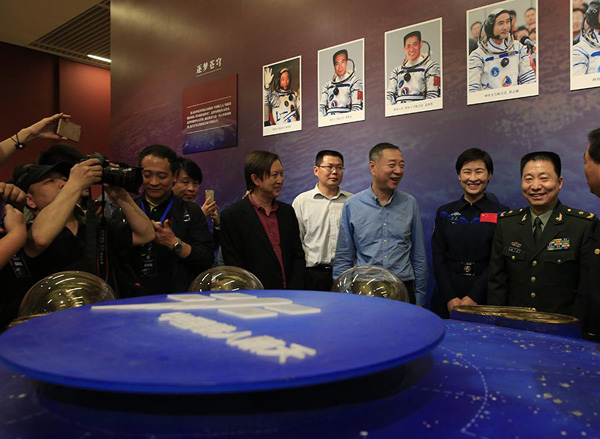|
|
|
Chinese astronauts Yang Liwei (first from right) and Liu Yang (second from right) at an Aerospace Objects Exhibition at the National Museum of China in Beijing on April 24, 2017. [Photo/China Daily] |
China will select the third batch of astronauts this year for its manned space exploration plan, according to Yang Liwei, deputy director of the China Manned Space Engineering Office and China’s first astronaut to go into space.
“The new batch will have 10 to 12 astronauts, including around two females,” Yang said on May 16 in an interview with China Youth Daily.
China has already completed the first two steps in the three-step process: sending manned spacecraft into space; carrying out extravehicular activities and docking moves and establishing space labs. The third step is to establish long-term manned space station.
After Tianzhou 1 cargo spacecraft docked with Tiangong II space lab, refueling and resupplying it in April, China completed the experiments and tests on the manned space lab missions, Yang said.
During the third step to build the space station, more scientific experiments will be carried out, requiring astronauts to have more expertise, Yang said.
“Astronauts in the first batch were required to have bachelor’s degrees and pilots’ license. But now, new astronauts will focus on the engineering side. They should have master’s degrees to work as engineers and researchers,” Yang said.
New astronauts might face lower physical standards set for past astronauts in selection and training, but they should have more stable mental endurance, allowing them to work in a small place with heavy work for a long period, Yang said. The checks on chronic disease will be stricter.
“People who have suffered fractures have no chance. The appendicitis surgery might be tolerable, but any surgery on the chest is unacceptable. The nearsighted people also have no chance because the extreme pressure while entering the space will easily cause retinal detachment,” Yang said.
Yang added that according to an initial plan, China might choose new astronauts every four years depending on the missions and training situations.
China will launch Long March 5B carrier rocket into space in 2019, and after that, the rocket will help carry the core module of China’s space station into space. Shenzhou XII and Shenzhou XIII spacecrafts will be launched soon after that.
But the crew of Shenzhou XII will consist of astronauts from the first and second batches, Yang said.
China has selected astronauts in two batches, 14 in 1990s and seven in 2010.
Follow this news feed: East Asia






